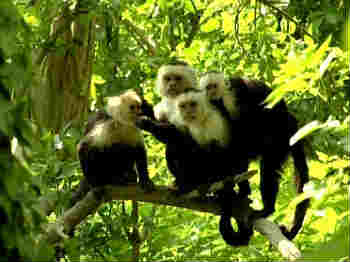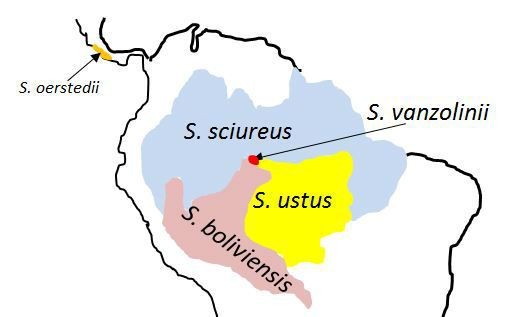Capuchins and Squirrel Monkeys
Family Cebidae
Mammalian Hybrids
EUGENE M. MCCARTHY, PHD GENETICS, ΦΒΚ
Cebus albifrons [White-fronted Capuchin]
× Cebus apella [Brown Tufted Capuchin] CHR. CON: Colombia, northwestern Brazil. International Zoo Yearbook 1989 (p. 314); Martin et al 1974; Zuckerman 1933 (p. 98).
× Cebus capucinus [White-faced Capuchin] CANHR(Colombia). Torres de Caballero et al. (1976) report two male hybrids from Miraflores (Vaupes). An internet site (MONK) mentions a hybrid produced in captivity.
× Cebus olivaceus [Weeping Capuchin] CHR. Parapatric contact in northern Amazonia. Howletts Wild Animal Park (UK) had a hybrid. Internet Citations: DPZ.
Cebus apella [Brown Tufted Capuchin]
See also: Cebus albifrons.
× Cebus capucinus [White-faced Capuchin] CHR(Giardino Zoologico di Roma). DRS. A male hybrid has been reported. International Zoo Yearbook 1975 (p. 360), 1977 (p. 302).
× Cebus olivaceus [Weeping Capuchin] CHR(Inuyamu, Japan). CON: northern South America. International Zoo Yearbook 1973 (p. 320).
Cebus capucinus [White-faced Capuchin] See: Cebus albifrons; C. apella.
Cebus libininosus [Black-striped Capuchin]
× Cebus nigritus [Black-horned Capuchin] ENHR. HPF. Hybrid zones exist along the Rio Grande in Minas Gerais and São Paulo (Brazil). These forms are sometimes lumped due to hybridization. Both were usually treated as subspecies of C. apella until 2001. Fantini et al. 2011; Kinzey 1981.
Cebus nigritus [Black-horned Capuchin] See: Cebus libininosus.
Note: Vande Berg et al. (1990b) report a hybrid between two forms (boliviensis, peruviensis) usually treated as races of Saimiri boliviensis, though sometimes as separate species.
Saimiri boliviensis [Bolivian Squirrel Monkey]
× Saimiri sciureus (↔) [Common Squirrel Monkey] CAENHR. CON: eastern Peru. HPF(vh). These hybrids are common in captivity. There is a hybrid zone between the Ucayali and Tapiche rivers, and hybridization presumably occurs, too, elsewhere along the lengthy boundary where these two monkeys meet in western Amazonia. Although these forms are usually treated as separate species, Thorington (1985) lumped them when he found they hybridize. These squirrel monkeys are sometimes distinguished by the epithets “Roman Arch” and “Gothic Arch,” which refer to the shape of their supraorbital facial patterns. Descailleaux et al. 1989; Fogle 1990†; Jones et al. 1973; Newman and Symmes 1982; Schreiber et al. 1998; Silva et al. 1992, 1993; Vande Berg et al. 1990a, 1990b.
× Saimiri ustus [Bare-eared Squirrel Monkey] See: Saimiri ustus × S. vanzolinii.
× Saimiri vanzolinii [Black Squirrel Monkey] ENHI. Costello et al. (1993, p. 206) say populations of S. boliviensis adjacent to S. vanzolinii approach S. vanzolinii in coat pattern, which makes them PHPs of this cross.
Saimiri oerstedii [Central American Squirrel Monkey] Although squirrel monkeys are abundant and widespread in South America, The IUCN rates the Central American squirrel monkey as vulnerable. It occurs in a region, the Pacific wet lowlands of Costa Rica and Panama, widely separated from the ranges of other squirrel monket ys. Some experts believe S. oerstedii is a hybrid population introduced by pre-Colombian Amerind traders derived from distinct types of squirrel monkeys introduced from various localities in South America. On the basis of nuclear and mitochondrial DNA sequence data, Cropp and Boinski (2000) felt they had rejected this hypothesis. However, Chiou et al. (2011) found that a sample S. oerstedii mtDNA haplotypes were more than 99% similar to some Saimiri sciureus haplotypes, which was even more similar than were some of the other S. sciureus haplotypes evaluated in their study. This finding is consistent with, though it does not confirm, the hypothesis that is derived from hybridization involving S. sciureus females.
Saimiri sciureus [Common Squirrel Monkey]
See also: Saimiri boliviensis and "Springhare + Common Squirrel Monkey."
× Saimiri ustus [Bare-eared Squirrel Monkey] ENHR(Brazil). A male specimen in the Emilio Gouldi collection (MG13210) taken on the right bank of the Rio Tefé at the mouth of Rio Bauana (Ponta da Castanha: see Ayres 1985, Map 1) is thought to be this hybrid. It has the fulvous hands and burnt-orange dorsum of ustus, but the gray auricular patch of sciureus. The Museu de Zoologia has additional probable hybrids (MZ19013, MZ19014, MZ19015) collected on the Rio Tefé’s east bank (from Vila Vale). Other intermediate specimens were collected between the Rio Madeira and Rio Tapajós. Costello et al. 1993 (pp. 196-198).
Saimiri ustus [Bare-eared Squirrel Monkey]
See also: Saimiri boliviensis; S. sciureus.
× Saimiri vanzolinii [Black Squirrel Monkey] A female specimen in the Emilio Gouldi collection (MG13209) taken at Lago Boia (w bank of the Rio Tefé, Brazil) is thought to be either this hybrid or Saimiri boliviensis × S. ustus. The former however, was thought to be more likely due to the proximity in that region of the putative parents. Costello et al. 1993 (pp. 196-197).
Saimiri vanzolinii [Black Squirrel Monkey] See: Saimiri boliviensis; S. ustus. This monkey lives in central Amazonia in the várzea forest at the confluence of the Japura and Solimoes rivers (see map above). No one seems to have suggested it, but the possibility should be investigated that vanzolinii may be of hybrid origin. It has a tiny range in comparison with the other three commonly recognized South American squirrel monkeys (Saimiri boliviensis, Saimiri sciureus and Saimiri ustus) and it occurs at the common intersection of their three ranges (see map above). These facts are consistent with the idea that it may simply be the product of a three-way hybrid zone, a very common phenomenon with other types of animals. S. sciureus is already known to hybridize in a state of nature with both S. boliviensis and S. ustus. And, the latter two, which are very similar animals, will likely also turn out to hybridize once their remote zone of contact is investigated. As Costello et al. (1993, p. 206) point out, no pre-mating behaviors are known that might reproductively isolate “any one Saimiri group from any other. All squirrel monkeys share the same feeding strategy, diet, and breeding systems.”
By the same author: Handbook of Avian Hybrids of the World, Oxford University Press (2006).

